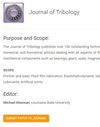Tribological properties of several surface modified piston rings under extreme conditions
IF 3
3区 工程技术
Q2 ENGINEERING, MECHANICAL
引用次数: 0
Abstract
This paper explores the performance of different commercial piston rings when matched with a boron-phosphorus (BP) alloy cast iron cylinder liner, specifically in high-power density diesel engines. The focus is on the friction, wear, and scuffing characteristics. An interrupted wear test was conducted under lean oil conditions to study the scuffing behavior of plated Cr-diamonds coating (GDC) and diamond-like carbon coating (DLC). The findings reveal that DLC coatings exhibit superior tribological properties, displaying low friction coefficients and wear loss at temperatures of 150 °C and 240 °C. In contrast, GDC coatings demonstrate relatively poor performance. Additionally, the DLC coating demonstrates excellent scuffing resistance, as no material transfer was observed for up to 77 minutes, even without lubrication. The interrupted scuffing test reveals that the scuffing process undergoes a stable wear stage, followed by a sudden drop and subsequent increase in friction force, ultimately resulting in scuffing when the BP cylinder is paired with GDC. On the other hand, although the frictional force of DLC initially increases after a brief decline, no significant adhesive wear is observed. This can be attributed to the formation of a tribo-chemical layer of carbides, which effectively prevents scuffing. In comparison to traditional methods of post-wear morphology and analysis, our proposed interrupted scuffing tests offer enhanced capabilities for evaluating the wear condition of friction pairs at various time intervals during the oil depletion process. This novel approach introduces a new paradigm for investigating wear patterns in different friction pairs.几种表面改性活塞环在极端条件下的摩擦学性能
本文探讨了不同商用活塞环与硼磷合金铸铁缸套匹配时的性能,特别是在高功率密度柴油发动机中。重点是摩擦、磨损和胶合特性。在稀油条件下进行了断续磨损试验,研究了镀Cr金刚石涂层(GDC)和类金刚石碳涂层(DLC)的胶合行为。研究结果表明,DLC涂层表现出优异的摩擦学性能,在150°C和240°C的温度下表现出较低的摩擦系数和磨损损失。相比之下,GDC涂层表现出相对较差的性能。此外,DLC涂层表现出优异的耐磨性,因为即使没有润滑,在长达77分钟的时间内也没有观察到材料转移。间断磨损试验表明,当BP气缸与GDC配对时,磨损过程经历了一个稳定的磨损阶段,随后摩擦力突然下降并随后增加,最终导致磨损。另一方面,尽管DLC的摩擦力在短暂下降后最初增加,但没有观察到显著的粘合磨损。这可以归因于碳化物的摩擦化学层的形成,它有效地防止了磨损。与传统的磨损后形态和分析方法相比,我们提出的间断磨损试验提高了评估油耗尽过程中不同时间间隔摩擦副磨损状况的能力。这种新方法为研究不同摩擦副的磨损模式引入了一种新的范式。
本文章由计算机程序翻译,如有差异,请以英文原文为准。
求助全文
约1分钟内获得全文
求助全文
来源期刊
CiteScore
4.20
自引率
12.00%
发文量
117
审稿时长
4.1 months
期刊介绍:
The Journal of Tribology publishes over 100 outstanding technical articles of permanent interest to the tribology community annually and attracts articles by tribologists from around the world. The journal features a mix of experimental, numerical, and theoretical articles dealing with all aspects of the field. In addition to being of interest to engineers and other scientists doing research in the field, the Journal is also of great importance to engineers who design or use mechanical components such as bearings, gears, seals, magnetic recording heads and disks, or prosthetic joints, or who are involved with manufacturing processes.
Scope: Friction and wear; Fluid film lubrication; Elastohydrodynamic lubrication; Surface properties and characterization; Contact mechanics; Magnetic recordings; Tribological systems; Seals; Bearing design and technology; Gears; Metalworking; Lubricants; Artificial joints

 求助内容:
求助内容: 应助结果提醒方式:
应助结果提醒方式:


